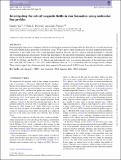Files in this item
Investigating the role of magnetic fields in star formation using molecular line profiles
Item metadata
| dc.contributor.author | Yin, Charles | |
| dc.contributor.author | Priestley, Felix D | |
| dc.contributor.author | Wurster, James | |
| dc.date.accessioned | 2021-05-07T15:30:05Z | |
| dc.date.available | 2021-05-07T15:30:05Z | |
| dc.date.issued | 2021-06 | |
| dc.identifier | 274064634 | |
| dc.identifier | 159380e8-9354-4db5-b3c1-bb58748c4b62 | |
| dc.identifier | 000659453800056 | |
| dc.identifier | 85107911907 | |
| dc.identifier.citation | Yin , C , Priestley , F D & Wurster , J 2021 , ' Investigating the role of magnetic fields in star formation using molecular line profiles ' , Monthly Notices of the Royal Astronomical Society , vol. 504 , no. 2 , pp. 2381–2389 . https://doi.org/10.1093/mnras/stab1039 | en |
| dc.identifier.issn | 0035-8711 | |
| dc.identifier.other | Jisc: 4ece05823ce34f6ab8624d24a83192a6 | |
| dc.identifier.other | ORCID: /0000-0003-0688-5332/work/93515159 | |
| dc.identifier.uri | https://hdl.handle.net/10023/23132 | |
| dc.description | FDP is funded by the Science and Technology Facilities Council. | en |
| dc.description.abstract | Determining the importance of magnetic fields in star-forming environments is hampered by the difficulty of accurately measuring both field strength and gas properties in molecular clouds. We post-process three-dimensional non-ideal magnetohydrodynamic simulations of pre-stellar cores with a time-dependent chemical network, and use radiative transfer modelling to calculate self-consistent molecular line profiles. Varying the initial mass-to-flux ratio from subcritical to supercritical results in significant changes to both the intensity and shape of several observationally important molecular lines. We identify the peak intensity ratio of N2H+ to CS lines, and the CS J = 2–1 blue-to-red peak intensity ratio, as promising diagnostics of the initial mass-to-flux ratio, with N2H+/CS values of >0.6 (<0.2) and CS blue/red values of <3 (>5) indicating subcritical (supercritical) collapse. These criteria suggest that, despite presently being magnetically supercritical, L1498 formed from subcritical initial conditions. | |
| dc.format.extent | 952422 | |
| dc.language.iso | eng | |
| dc.relation.ispartof | Monthly Notices of the Royal Astronomical Society | en |
| dc.subject | Astrochemistry | en |
| dc.subject | MHD | en |
| dc.subject | Stars: formation | en |
| dc.subject | ISM: magnetic fields | en |
| dc.subject | ISM: molecules | en |
| dc.subject | QB Astronomy | en |
| dc.subject | QC Physics | en |
| dc.subject | NDAS | en |
| dc.subject.lcc | QB | en |
| dc.subject.lcc | QC | en |
| dc.title | Investigating the role of magnetic fields in star formation using molecular line profiles | en |
| dc.type | Journal article | en |
| dc.contributor.institution | University of St Andrews. School of Physics and Astronomy | en |
| dc.identifier.doi | 10.1093/mnras/stab1039 | |
| dc.description.status | Peer reviewed | en |
This item appears in the following Collection(s)
Items in the St Andrews Research Repository are protected by copyright, with all rights reserved, unless otherwise indicated.

